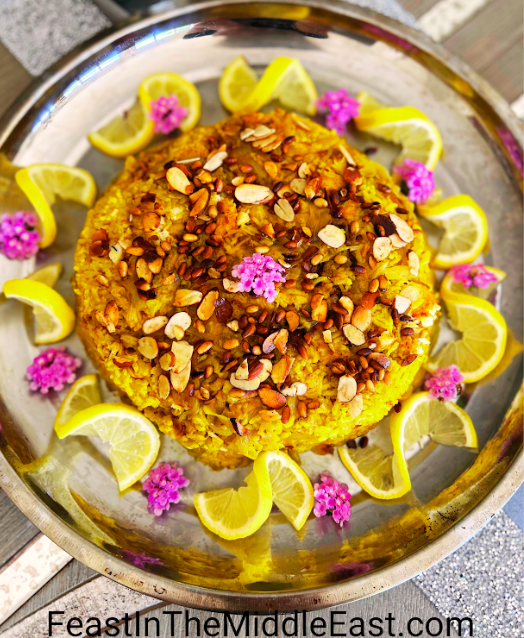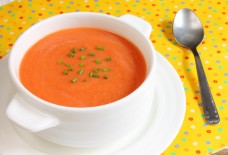Sayadieh: The Classic Fish and Rice Dish Of the Levant

By: Blanche Shaheen/Arab America Contributing Writer
Sayadieh, a dish renowned for its exquisite blend of flavors and textures, holds a significant place in the culinary traditions of the Levant region, particularly in Lebanon and the coastal regions of Palestine like Gaza and Akka. This specialty, characterized by its fragrant rice and tender and flaky whitefish, offers a glimpse into the rich cultural heritage and culinary expertise of the Middle East.
The name “sayadieh” is derived from the Arabic word “Sayyad,” meaning fisherman. Historically, it is believed that the dish originated in the coastal regions where fishing was a prominent livelihood. Fishermen would prepare this meal using freshly caught fish along with rice and an array of spices, creating a hearty and satisfying meal.
Over time, Sayadieh evolved from a simple fisherman’s fare into a dish enjoyed across various social settings, from family gatherings to festive celebrations. Its popularity spread across the Levant and into neighboring regions, each area adding its own unique twist to the recipe while staying true to its core ingredients and preparation methods.
Sayadieh typically features fish as the star ingredient, often using varieties like grouper, cod, or red snapper, which are readily available in the Mediterranean and Arabian Sea. The fish is usually cooked whole or in large filets, seasoned generously with spices such as cumin, turmeric and paprika, which impart a smoky flavor.
The rice component of Sayadieh is equally important and is cooked with caramelized onions, which lend a sweet undertone to the dish. Some variations include nuts like almonds or pine nuts, adding a crunchy texture and enhancing the overall richness of the dish. A squeeze of lemon juice before serving brightens the flavors and balances the savory notes of the fish and rice.
In many Middle Eastern cultures, Sayadieh holds cultural and social significance. It is often served during festive occasions such as weddings and religious holidays, symbolizing abundance and hospitality. It is served flipped upside down similarly to Maqlouba. The communal act of sharing a platter of Sayadieh reflects the region’s tradition of generosity and togetherness around food.
As with any beloved dish, Sayadieh has variations that cater to different tastes and regional preferences. Some versions use tomato-based sauces or incorporate vegetables like carrots and bell peppers, adding color and additional layers of flavor. In coastal towns, variations may include locally caught seafood such as shrimp or calamari, further enriching the dish’s seafood profile.
Sayadieh stands as a testament to the culinary prowess of the Levant region, where simple ingredients are transformed into a dish that delights the senses and nourishes the soul. Whether enjoyed at a bustling family dinner or a festive gathering, Sayadieh continues to evoke a sense of tradition and connection to the sea, reminding us of the rich cultural heritage that flavors every bite.
Some Tips:
You can use any kind of whitefish, though the more robust the better so it can hold its own without falling apart in the pot. I have used cod, barramundi, halibut, and even petrale sole with success.
Flavor each component, including the rice, before cooking the elements together. Often cooks season the rice in the pot, which can leave clumps in the rice in one area, and not enough seasoning in another area.
To see the easy technique, click on the video below:
Sayadiya
Ingredients
- 2 cups Basmati rice
- 2 tsp salt, divided, plus more to taste
- 4 tsp turmeric, divided
- 4 large yellow onions, sliced
- 1 tsp cumin
- Pepper to taste
- 1 tbsp Fish spice blend plus more for sprinkling on fish (can also use baharat, 7 spice blend, or to make your own by mixing 1 tsp paprika, 1 tsp cumin and 1 tsp coriander)
- 2 pounds sturdy whitefish (like cod, barramundi, rockfish, snapper, petrale sole, halibut)
- 1 cup flour
- 1/4 cup olive oil, plus 2 tbsp more oil for frying the fish
- 1/3 cup pine nuts and/or almonds for garnishing
- 3 cups of chicken broth, plus one cup of water
Instructions
- Rinse the rice, drain, then put in a bowl. Add about 1 tsp of salt, 1 tsp cumin and 2 tsp turmeric, combine well, and set aside. This will ensure the rice is seasoned evenly, rather than adding the spices to the pot later.
- Slice the onions into slivers. In a pot, heat 1/4 cup olive oil, and add the onions. Continue stirring until light brown, and add about ½ tsp salt to season at the end. Set aside.
- To prepare the fish coating, in a bowl mix the flour with 1 tsp salt, pepper to taste, 1 tablespoon fish spices, and the remaining 2 tsp of turmeric. Then, cut the fish into medium sized chunks and sprinkle with salt, pepper, and more fish spice ( if your fish spice is already salted you can omit the salt). Coat the fish with the flour, shaking off any excess flour. In a skillet, add 2 tbsp of olive oil, and fry the fish until golden brown. Don’t worry about the fish being cooked through, as it will finish cooking with the rice. Set aside.
- Now it’s time to assemble everything in a pot. Make sure that the onions are evenly distributed on the bottom of the pot, and then gently layer the fish over them. Add the seasoned rice and spread it over the fish. Then take the chicken broth and one cup water, and pour it over the onions, fish, and rice. Boil the broth, then cover and reduce the heat to a simmer on low to cook for 20 more minutes. Turn off the heat, and leave the pot covered for 20 more minutes before serving.
- When ready to serve, fip the pot onto your serving plate and top with the nuts. The longer you allow the dish to rest, the better it will hold once it is flipped. Serve with lemon wedges, salata baladia, or cucumber tomato salad, and a dollop of yogurt if desired.
Blanche Shaheen is an Emmy Award winning journalist, host of the YouTube cooking show called Feast in the Middle East, and cookbook author. For more authentic and classical Middle Eastern recipes, you can purchase her cookbook, “Feast In the Middle East here: https://secure.mybookorders.com/mbo_index.php?isbn=9781545675113 For her cooking video tutorials, visit https://www.youtube.com/user/blanchetv Her recipes can also be found at https://feastinthemiddleeast.wordpress.com/








